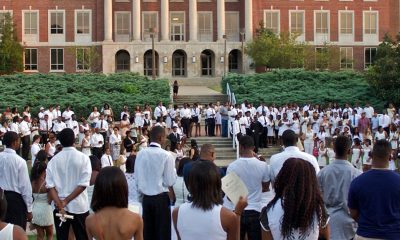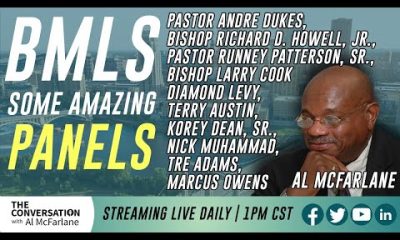Black History
COMMENTARY: The Morris Building Should be a Civil Rights Museum
THE TENNESSEE TRIBUNE — Though many may not realize it, Nashville was one of the key locales in the Movement from its inception.
NASHVILLE, TN — The Morris building and property is the ideal location for Nashville to construct its own Civil Rights Museum, something that has long been needed to highlight and celebrate a vital part of our city’s heritage.
Though many may not realize it, Nashville was one of the key locales in the Movement from its inception. While Greensboro was the site of the first sit-ins, Nashville students were soon active participants as well. The distinguished Rev. James Lawson, then a Vanderbilt Divinity student, sacrificed his early education to play a major role, and Fisk University’s Race Relations Institute served as a think tank where strategy sessions and major meetings were frequently held. Rev. Kelly Miller Smith, Sr. as president of the Nashville NAACP, founder and president of the Nashville Christian Leadership Conference (NCLC), and a founding board member of the Nashville Urban League, was one of the city’s most influential black leader’s involved in the civil rights movement in Nashville.
Nashville was the most prominent key center of the Civil Rights Movement that doesn’t have its own museum saluting our history. Such cities as Atlanta, Greensboro, Birmingham, Memphis, Charleston and Jackson, Mississippi already have highly touted, popular Civil Rights Museums. Even other areas like Cincinnati, Detroit, and both New York City (the Schomburg) and Auburn, New York (Harriet Tubman’s home) have museums that acknowledge their municipalities’ Civil Rights Heritage, and of course there’s the National Black History and Culture Museum in Washington, D.C.
While Nashville’s bustling hierarchy of black music institutions was sacrificed due to urban renewal (Negro removal) and interstate construction, there remains in the downtown public library’s Civil Rights room records of many Nashville personalities who played a major role in the Movement. That does not provide a more suitable foundation for a Museum. The Morris building would also be a natural fit with the city’s 25 white museums.
The Morris Bldg. project would increase employment opportunities and it would not only provide more diverse interest but it would certainly resonate with the Mayor’s stated goal of expanded access for Black owned businesses and individuals that allows them to more fully participate in Nashville’s continuing growth and progress.
The Morris Building dates back to the mid-1920s, when it was established as the publishing arm of the National Baptist Convention. While we understand there are other uses under consideration for this property, we can’t think of one more suitable for a building originally designed by one of the nation’s first black-owned architectural firms, and one that’s part of a business district that has not received the respect, attention or consideration it deserves.
The creation of a Civil Rights Museum would be a big step towards revitalizing the entire area, and also recognize a part of our city’s heritage that is too often only noted in passing or briefly during Black History Month. Nashville’s role in the Civil Rights Movement is as historic equally and is as important and noteworthy as anything else in Nashville’s history, including our emergence as the “It City” and the evolution of “Music City.”
Remember: Tennessee offers the chance to learn about the struggles and triumphs of African Americans who helped to shape and build our country in other parts of Tennessee: Alex Haley Museum & Interpretive Center – Henning; Dunbar Carver Museum – Brownsville; National Civil Rights Museum – Memphis; Slave Haven Underground Railroad Museum – Stax Mu Memphis; Stax Museum of American Soul Music – Memphis; Tina turner Museum and Flagg Grove School – Brownsville; Withers Collection Museum and Gallery – Memphis; Beck Cultural Center – Knoxville; Green McAdoo Cultural Center – Clinton; Bessie Smith Culture Center – Chattanooga; McLemore House Museum – Franklin; Nashville should take this step and make Nashville’s Civil Rights Museum the best in the nation, one befitting of its impact on the greatest social movement of the 20th century.
This article originally appeared in The Tennessee Tribune.
Activism
Oakland Post: Week of April 24 – 30, 2024
The printed Weekly Edition of the Oakland Post: Week of April 24 – 30, 2024

To enlarge your view of this issue, use the slider, magnifying glass icon or full page icon in the lower right corner of the browser window. ![]()
Activism
Oakland Post: Week of April 17 – 23, 2024
The printed Weekly Edition of the Oakland Post: Week of April 17 – 23, 2024

To enlarge your view of this issue, use the slider, magnifying glass icon or full page icon in the lower right corner of the browser window. ![]()
Black History
Matthew Henson: Explorer Extraordinaire
Matthew Henson, a trailblazing explorer who overcame countless obstacles to leave an incredible mark on history. Born on August 8, 1866, in Charles County, Maryland, his journey is a testament to the power of determination and the spirit of adventure.

By Tamara Shiloh
Matthew Henson, a trailblazing explorer who overcame countless obstacles to leave an incredible mark on history. Born on August 8, 1866, in Charles County, Maryland, his journey is a testament to the power of determination and the spirit of adventure.
Henson’s life began amidst the backdrop of post-Civil War America, where opportunities for African Americans were scarce. From a young age, he possessed an insatiable curiosity about the world beyond his small town. At the age of 12, he embarked on a journey that would change the course of his life forever when he joined a merchant ship as a cabin boy.
His most famous expedition was his journey to the Arctic with renowned explorer Robert E. Peary. In 1887, Henson joined Peary’s crew as a seaman and quickly proved himself to be invaluable with his skills as a navigator and craftsman. Over the course of several expeditions, Matthew endured extreme cold, treacherous terrain, and grueling conditions as he and Peary sought to reach the elusive North Pole.
In 1908–09, Peary set out on his eighth attempt to reach the North Pole. It was a big expedition, with Peary planning to leave supplies along the way. When he and Henson boarded their ship, the Roosevelt, leaving Greenland on August 18, 1909, they were joined by a large group. This included 22 Inuit men, 17 Inuit women, 10 children, 246 dogs, 70 tons of whale meat, blubber from 50 walruses, hunting gear, and tons of coal.
In February, Henson and Peary left their anchored ship at Ellesmere Island’s Cape Sheridan, along with the Inuit men and 130 dogs. They worked together to set up a trail and supplies along the way to the Pole.
Peary picked Henson and four Inuit people to join him in the final push to the Pole. However, before they reached their destination, Peary couldn’t walk anymore and had to ride in a dog sled. He sent Henson ahead to scout the way. In a later interview with a newspaper, Henson recalled being in the lead and realizing they had gone too far. The group turned back, and Henson noticed his footprints helped guide them to their destination. At that location, Henson planted the American flag.
Henson’s legacy extends far beyond his expeditions to the Arctic. He shattered racial barriers in the world of exploration and inspired countless individuals, regardless of race, to dream big and pursue their passions. In 1937, he was finally recognized for his achievements when he was inducted into The Explorers Club, an organization dedicated to promoting scientific exploration and field research.
Matthew Henson died in the Bronx, New York, on March 9, 1955, at the age of 88.
-

 Community2 weeks ago
Community2 weeks agoFinancial Assistance Bill for Descendants of Enslaved Persons to Help Them Purchase, Own, or Maintain a Home
-

 Activism4 weeks ago
Activism4 weeks agoOakland Post: Week of April 3 – 6, 2024
-

 Business2 weeks ago
Business2 weeks agoV.P. Kamala Harris: Americans With Criminal Records Will Soon Be Eligible for SBA Loans
-

 Community2 weeks ago
Community2 weeks agoAG Bonta Says Oakland School Leaders Should Comply with State Laws to Avoid ‘Disparate Harm’ When Closing or Merging Schools
-

 Activism3 weeks ago
Activism3 weeks agoOakland Post: Week of April 10 – 16, 2024
-

 Community1 week ago
Community1 week agoOakland WNBA Player to be Inducted Into Hall of Fame
-

 Community1 week ago
Community1 week agoRichmond Nonprofit Helps Ex-Felons Get Back on Their Feet
-

 City Government2 weeks ago
City Government2 weeks agoLAO Releases Report on Racial and Ethnic Disparities in California Child Welfare System
























































